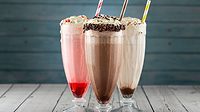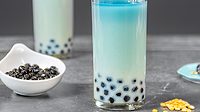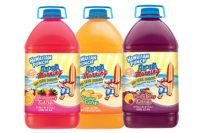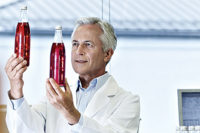In recent years, consumer concerns about sugar intake have created a macrotrend of healthier beverages. As a result, the beverage industry has seen natural sweeteners like stevia evolve and become more widely used. In fact, use of plant-derived sweeteners, such as stevia, tripled among food and beverage product launches from 2009 to 2013, according to a recent report from Chicago-based Mintel and Leatherhead Food Research, Surrey, United Kingdom. However, artificial sweeteners, such as acesulfame potassium, sucralose and aspartame, are still dominant among new product launches, the report notes.
Acesulfame potassium, also known as Ace K, led intense sweeteners in terms of food and beverage launch activity last year because of its common usage in sweetener blends, the report states. The sweetener was used in nearly half of new product launches in 2013; however, its usage has declined 7 percentage points since 2009. Sucralose is the next most popular intense sweetener in terms of new product launches. It has remained stable for the past five years and made an appearance in approximately 40 percent of all food and beverages with an intense sweetener launched last year, according to the report. Aspartame took the No. 3 spot with about one-third of new product launches.
Mainstream appeal
Helping to combat the negative media reports about aspartame, the European Food Safety Authority conducted a full risk assessment reviewing all available scientific research on aspartame and its breakdown products, including both animal and human studies, in December 2013. It concluded that aspartame and its breakdown products are safe for human consumption at current levels of exposure. Prior to this finding, the ingredient continued to drop in terms of its usage rate in food and beverage products, according to the Mintel and Leatherhead Food Research report. In 2009, 40 percent of product launches contained aspartame, whereas 32 percent of 2013 launches included the ingredient, it states.
Nevertheless, many categories, such as carbonated soft drinks (CSDs), still rely on artificial variants for sweetness, the report adds. Consumers are showing an interest in natural sweeteners, but they will not compromise on taste, regardless of the source of the sweetener, says Ihab Bishay, senior director of new business development and application innovation for Ajinomoto North America Inc., Fort Lee, N.J.
“Over and over again, consumers have shown that taste is what drives product success, so when they are looking to reduce sugar and calories, they are not willing to sacrifice on taste,” he says. “If a consumer becomes disappointed by [a product’s] taste profile, they will not become repeat customers.”
Recent research completed in part by Mintel and Nielsen, New York, and commissioned by the Corn Refiners Association, Washington, D.C., affirms this behavior. The market research firms’ Sweetener360 research study found that although consumers say they are trying to live a healthy lifestyle and avoid specific sweeteners, their receipts show otherwise. Purchase data showed that these “healthy lifestyle” consumers continued to buy sweetened products at the same rate as other segments, says Sara Martens, vice president of The MSR Group, Omaha, Neb. The study also found that 67 percent of consumers agree that to be healthy, moderation is more important than avoiding specific sweetening ingredients, such as high-fructose corn syrup (HFCS).
Furthermore, Nielsen data indicates that brands that have reformulated to omit HFCS generally have not seen an increase in sales, Martens notes.
“Nielsen has tracked introductions and performance of HFCS-free products since 2010 as part of a comprehensive review of sweetener formulation strategies,” she says. “The shopper data comes from all outlets and covers the sales of 25 leading brands across more than 3,200 SKUs in beverages, baked goods and prepared foods. What the receipts show is conclusive: Regardless of market strategy, almost all brands that switched to HFCS-free formulations have consistently seen flat or falling market share.”
Research confirms that taste and price are king, Martens says. “If it doesn’t taste good and isn’t affordable, consumers won’t buy it.”
Battling stigmas
Ajinomoto’s aspartame is approximately 200 times sweeter than sugar on a weight-for-weight basis, according to the company’s website. Bishay adds that the company continues to get requests for clean-tasting sweetness that enhances flavors instead of distorting them. This helps to maintain aspartame’s relevance and popularity in the market, he says.
The supplier’s newest sweetening ingredient, Advantame, is derived from aspartame and vanillin and is approximately 20,000 times sweeter than sugar and 100 times sweeter than aspartame, according to Ajinomoto’s website. The sweetener also recently completed the food additive petition process for general use in food and beverages based on U.S. Food and Drug Administration standards. It can be used to partially replace caloric sweeteners and other high-potency sweeteners in a variety of beverages while maintaining the same taste profile, Bishay notes. Both of these sweeteners also can help beverage-makers manage their sweetness costs, he says. Plus, Advantame has the ability to mask off-notes of functional ingredients, such as protein and superfruits, and even natural sweeteners, he adds.
Like aspartame, HFCS has received negative media attention in recent years. Nevertheless, HFCS is one of the most versatile ingredients on the market, The MSR Group’s Martens says. The sweetening ingredient adds texture, helps maintain color and quality, and enhances flavor in many foods and beverages, she says. Plus, because it comes in liquid form, it is easier to handle during the manufacturing process and less expensive, she adds.
Shift to natural
Despite the established nature of sweeteners like aspartame and HFCS in the beverage industry, consumer interest in ingredient safety, naturalness and calorie content is causing many beverage-makers to adjust their sweetener strategies, notes David Nichols, global marketing manager for PureCircle, Oak Brook, Ill. To his point, stevia was included in nearly 240 new beverages launched in the United States between January 2013 and January 2014, which is a 119 percent increase from the prior year, according to Mintel’s Global New Products Database.
Offering a range of stevia sweeteners and natural flavors for beverage formulation, PureCircle receives requests for zero-calorie ingredients and taste parity most often, Nichols says. In 2013, the company supplied enough stevia to enable a reduction of 500 billion calories from global diets, Director of Corporate Sustainability Ajay Chandran said in a statement. Plus, its Stevia 3.0 platform offers a customizable approach to formulating with stevia in order to achieve deep calorie reductions while maintaining superior taste, Nichols says.
Minneapolis-based Cargill recently launched its ViaTech stevia-based sweetener portfolio, which also aims to deliver optimal taste and sweetness, says Scott Fabro, global business development director for corn milling in North America. He notes that the company’s proprietary taste-prediction model can accurately predict what combination of steviol glycosides will deliver the best taste profile.
“The unique technology results in a proprietary composition of ingredients that delivers optimum taste and performance for the most challenging reduced-calorie applications,” he explains. “Therefore, the ViaTech portfolio enables customers to achieve greater sugar reduction in challenging applications while achieving optimal sweetness.”
Also in the natural realm, Cargill’s Zerose erythritol is a polyol sweetener that is 60-70 percent as sweet as sugar without any calories or aftertaste, notes Gustavo Strasser, polyols product line manager for Cargill.
Specialty certifications
Although natural sweeteners, such as stevia and erythritol, have experienced increased demand from consumers, beverage-makers are getting even more specific with their sweetener requests. According to Luis Ferrey, marketing manager for beverages with Ingredion Inc., Westchester, Ill., beverage manufacturers commonly request that ingredients be non-GMO, all-natural and low cost so that their products can have a clean label with no added sugar, reduced sugar and reduced calories. “These requests are very popular due to growing awareness in health and wellness among consumers,” he says.
Taking these requests a step further, customers increasingly are requesting ingredient certifications, says Philip Coggins, director of commercial sales for Pyure Brands. As a result, the Naples, Fla.-based company offers a line of Non-GMO Project Verified extracts and organic stevia that is certified by the U.S. Department of Agriculture (USDA). Most recently, it introduced a Non-GMO Project Verified, USDA-certified-organic erythritol.
“It doesn’t matter how big the company is — it could be a small company or a large company that owns organic brands — most food and beverage manufacturers nowadays are looking for those products that have those kinds of certifications,” Coggins says.
Likewise, Senior Vice President of Sales and Marketing Mike Quin notes that Sweet Green Fields, Bellingham, Wash., has seen a steady increase in requests for certified-organic stevia ingredients as well as U.S.-grown stevia.
“Consumers perceive organic-labeled products to be more healthful,” he says. “Manufacturers see certified USDA organic as a bit of a safe haven for labeling claims.”
Sweet Green Fields recently launched a proprietary line of fully compliant USDA-certified-organic stevia extracts under the name Pure Organics. It also achieved an industry milestone with its new U.S.-based purification facility, which offers customers a choice of U.S.-grown conventional stevia as well as U.S.-grown organic stevia through its “select crops” program, Quin says.
“Companies both large and small have shown strong interest in our USA-grown and USA-purified products,” he says.
Overcoming off-notes
No matter what type of sweetener is selected for formulation, beverage-makers must be aware of potential off-notes when crafting their sweetening solutions, experts note.
For instance, oftentimes when stevia is used at high concentrations, it will result in bitter tastes or aftertastes, says Adrienne Pohrte, team leader for beverage applications at Tate & Lyle, Hoffman Estates, Ill. Approximately 83 percent of consumers are sensitive to this bitterness, according to sensory research conducted by Tate & Lyle. Therefore, the company developed Tasteva, a proprietary stevia sweetener, after analysis of the optimal composition of steviol glycosides, in-depth technical work, and extensive sensory testing, she says. Tasteva does not present an intense bitter or licorice aftertaste, which eliminates the need to supplement the stevia with other sweeteners or masking agents, she notes. Tate & Lyle also is well-known for manufacturing Splenda sucralose, which is a zero-calorie artificial sweetener that is approximately 600 times sweeter than sugar.
Additionally, replacing sugar with high-potency sweeteners can offer challenges in maintaining a beverage’s texture and mouthfeel due to the loss in solids, Pohrte adds. In this case, hydrocolloids or fibers can help to compensate for the loss, she says. Tate & Lyle offers Promitor soluble corn fiber that helps to improve mouthfeel and provides transparent fiber fortification with excellent digestive tolerance, she notes.
In addition to improving mouthfeel and rounding out the flavor profile of a beverage, fibers and carbohydrates can be used to impart their own mild sweetness as well as functional benefits. For instance, Beneo Inc. offers inulin oligofructose, which is a fiber that is approximately 30-50 percent as sweet as sugar and can offer weight management claims, says Joe O’Neill, president and general manager of the Morris Plains, N.J.-based company. Additionally, its Palatinose isomaltulose carbohydrate can provide partial sweetness as well as support balanced, sustained energy, help control blood sugars, and aid in weight management, he adds.
Similarly, Cargill offers Xtend sucromalt, which is 70 percent as sweet as sugar, says Deborah Schulz, specialty carbohydrates product line manager for Cargill.
These functional fibers and carbohydrates often are blended with other high-intensity sweeteners, including stevia, aspartame and Ace K, Beneo’s O’Neill says. However, because they offer a mild sweetness, they also can fit in with the trend toward less-sweet beverages, he adds.
Sweetener blends also can impart a better overall sweetness profile when compared with individual sweeteners and can reduce undesirable off-notes at the same time, says Ingredion’s Ferrey. These blends also come into play for mid-calorie CSDs and juice drinks, which have grown in popularity in recent years.
In terms of sweetener blends, Steviva Ingredients offers a few natural sweetening systems. The company’s StevivaBlend merges its SteviaSweet 95-60 stevia with naturally fermented erythritol to deliver a rounded, full mouthfeel similar to sugar but twice as sweet as sugar; Fructevia combines fructose, fructooligosaccharide and highly purified Reb A to provide a sweetness curve similar to HFCS or a blend of sugar and fructose; and Nectevia blends organic agave nectar with stevia for a liquid sweetening option designed to replace corn syrups, says Thom King, president of the Portland, Ore.-based company. Furthermore, the company is developing lines of syrups as plug-in replacements for dextrose-equivalent 42 percent HFCS, he notes.
Although natural sweeteners continue to gain share of the food and beverage market, the shift will be gradual, Pyure Brands’ Coggins says. At any rate, naturally derived sweeteners with certifications are where the industry is headed, he says.










